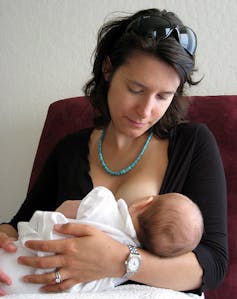Welcome to part six of The science behind weight loss, a series in which we separate the myths about dieting from the realities of exercise and nutrition. Here, Caroline Homer, Professor of Midwifery from the University of Technology Sydney, examines the pressures on women to lose weight after giving birth:
Women are often bombarded with contradictory advice after childbirth – from health professionals, family, friends, and other new mums on social networking sites – about how to shift the weight they gained during pregnancy.
Some of this advice is evidence-based and centred on eating a variety of nutritious foods and getting regular exercise. But much of it is based on fad diets, unrealistic claims and outdated information.
There is also a constant barrage of stories in the media about celebrities losing weight quickly after giving birth.
To assess the influence these stories have on women’s post-pregnancy body image and expectations, Heike Roth (a UTS Honours student), Professor Jennifer Fenwick and I recently analysed how the Australian media portrays the childbearing body through the use of celebrity stories in women’s magazines.
The stories glamorised speedy post-pregnancy weight loss and centered on three specific themes: “racing to bounce back”, “breastfeeding to bounce back” and “pretending to bounce back”.

“Exemplary women”, such as celebrities, “bounced back” to their pre-pregnant shape, often just a few weeks after giving birth.
And while the celebrities “raced” to get their bodies back, magazines competed with each other to publish the first pictures of the celebrity’s “new”, “improved”, post-pregnant body. This included advice about wearing body-shaping underwear and up-lifting bras to regain their figure.
The benefits of breastfeeding were frequently mentioned. But these stories prioritised breastfeeding as a way to lose weight and regain the pre-pregnancy body, rather than providing nutrition to the infant.
The post-pregnancy period is usually one of great joy and happiness, but a lack of sleep and physical and psychological problems – such as backache, urinary and faecal incontinence, depression and fatigue – make this an enormously challenging time.
These unrealistic stories of bouncing back from pregnancy create additional pressures on women to lose weight quickly, through fad diets and excessive exercise. And they’re unhelpful for a community striving to achieve a balance between an obsession with thinness and an epidemic of obesity.
Breastfeeding
The World Health Organization and Australia’s National Health and Medical Research Council recommend breastfeeding as the best source of nutrition for infants. Women should aim to breastfeed exclusively for the first six months.
There is compelling evidence that breastfeeding protects infants against a range of short and longer-term health problems such as allergies, infections and obesity.

A nutritious diet is important for a breastfeeding woman’s own health and energy levels. But contrary to popular belief, her diet has less of an impact on the quality of her breast milk and on her baby.
Even in countries where food is scarce, mothers are able to breastfeed and their babies thrive. As the Australian Breastfeeding Association notes, “a ‘perfect’ diet is not required for breastfeeding”.
Breastfeeding has long been promoted as a useful weight loss measure. But a recent review of the evidence from researchers at the University of Sydney shows this may not actually be the case.
Evidence from prospective cohort studies in developed countries showed the effect of exclusive breastfeeding on post-partum weight loss was negligible. Other factors, such as household income, baseline body mass index (BMI), ethnicity, gestational weight gain and energy intake, had a much larger impact on women’s ability to shed weight after birth.
Healthy weight
New mothers shouldn’t feel rushed to lose the weight they gained during pregnancy but it’s important they gradually achieve a healthy weight.
For many women, the first year or two after birth is a time when they start thinking about having another baby. Losing weight between pregnancies will help prevent incremental weight gain over successive pregnancies and avoid the risk of complications.
Pregnant women who are obese at the onset of pregnancy have a higher chance of developing pregnancy-related diabetes (gestational diabetes), increased blood pressure (hypertension), and problems with clots in the legs or the lungs.
It can be difficult for women with a new baby to get daily exercise as well as cope with a lack of sleep and other health concerns.
Women need support from friends, family and health professionals during this difficult time. They certainly don’t need to be bombarded with unrealistic stories about celebrity post-baby weight loss.
This is the sixth part of our series The science behind weight loss. To read the other instalments, follow the links below:
Part One: Diets and weight loss: separating facts from fiction
Part Two: Want to set up a weight loss scam? Here’s how…
Part Three: Feel manipulated? Anxious? Tune out the hype and learn to love your body
Part Four: Food v exercise: What makes the biggest difference in weight loss?
Part Five: An online tool to help achieve your weight-loss goal (no, it’s not a fad diet)
Part Seven: Quick and easy, or painful and risky? The truth about liposuction
Part Eight: Weight loss and the brain: why it’s difficult to control our expanding waist lines
Part Nine: Are diet pills the silver bullet for obesity?
Part Ten: Want to try the latest fad diet? Just ask your local pharmacist
Caroline Homer, Professor of Midwifery, University of Technology Sydney
This article was originally published on The Conversation. Read the original article.
![]()

